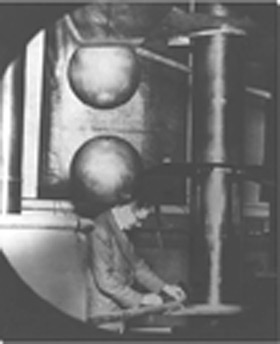Energy and Mass are Equivalent
 The first photograph showing the creation of a pair of particles, revealed by the fog spots they make in passing through the wet air of a 'cloud chamber.' The two particles, curving apart under the influence of a magnet, were created in the annihilation of a particle of light (coming invisibly from below). Photo Credit: AIP |
In September 1905, Einstein reported a remarkable consequence of his special theory of relativity: if a body emits a certain amount of energy, then the mass of that body must decrease by a proportionate amount. As he explained in a letter to a friend, "The relativity principle in connection with the Maxwell equations demands that the mass is a direct measure for the energy contained in bodies; light transfers mass... This thought is amusing and infectious, but I cannot possibly know whether the good Lord does not laugh at it and has led me up the garden path."
Einstein was not the first scientist to propose a relationship between mass and energy. As early as 1881, J. J. Thomson, who would later discover the electron, introduced the concept of the electromagnetic mass, establishing a connection between a particular kind of energy and a contribution to a body's mass. Theories of this sort were pursued by various physicists in the late nineteenth and early twentieth centuries, most notably by Max Abraham in Göttingen, who considered a model of the electron as a rigid sphere of uniform charge density. Lorentz modified this to allow the sphere to contract along its direction of motion. Poincaré‚ showed that to make Lorentz's model consistent required the addition of a new force, the Poincare‚ stress. These works hoped to use the observed relation between the energy, mass and velocity of the electron to determine which model was correct. Relativity swept this all away by showing that the correct relation, E = (mc2 , (1) where g-2 = 1- v2, is purely kinematical and holds for any particle of rest mass m whatever its internal dynamics.
In June of 1905 Einstein submitted the paper that contained the basic concepts of the special theory of relativity. In September, he submitted a brief sequel, in which by means of a simple argument based on kinematics and the known energy-momentum relation for electromagnetic radiation, he derived the equation that is forever associated with his name. A particularly nice version of Einstein's argument is given by Julian Schwinger in his book Einstein's Legacy (Dover Publications, 2002), pages 93-98.
 Atomic nuclei could be split apart in "atom-smashers" like this one built by Cockcroft and Walton. Photo Credit: AIP |
E=mc2 is the limit of equation (1) for v = 0. E is the energy of a body in its rest frame, m the rest mass, and c2 the square of the speed of light. In his September paper, Einstein already recognized that the energy of particles emitted by radioactive substances might cause the mass of these substances to decrease, and he advocated careful measurement of radium salts as a possible means of confirming his equation. Because c is so large in laboratory units, however, a small decrease in mass produces a lot of energy, so the reduction of mass in such processes proved much too small to observe.
Confirmation was in fact slow in coming. It was not until 1933 in Paris that Iréne and Frédéric Joliot- Curie obtained direct photographic evidence of the conversion of energy into mass. (See top photo). Meanwhile, in Cambridge, England, the reverse process was seen in 1932: the conversion of mass into energy. With their apparatus John Cockcroft and E.T.S. Walton bombarded a 7Li nucleus with a proton of energy 125 keV. The resulting fragments, 2 a-particles, had slightly less mass in total than the original 7Li + p, but they flew apart with an energy of 17.2 MeV. Using the known masses of the incoming and outgoing particles, it was possible to verify Einstein's equation explicitly.
E=mc2 is the underlying principle behind nuclear fission and fusion. In fission, an atomic nucleus splits apart into two or more fragments. But the masses of the fragments sum to less than the mass of the original nucleus. The missing mass is released in the form of heat and radiation. The release of energy in naturally occurring substances is too gradual to be of much practical use. Hungarian physicist Leo Szilard first proposed that a chain reaction could occur in a critical mass of uranium, due to the absorption of neutrons by the uranium nuclei, which would then fission and produce more neutrons, leading to an exponentially escalating series of decays. After many technical innovations and theoretical breakthroughs, this ultimately led to the first atomic bomb, as well as the nuclear reactors that convert mass energy to heat and thence to electric energy.
Energy is also released in the nuclear fusion of light atoms. At extremely high temperatures, the atomic nuclei fuse together to form the nucleus of a heavier atom, whose mass is less than the combined masses of the original atoms. This missing mass is released as kinetic energy. As shown by the masterly analysis of Hans Bethe and others, various fusion reactions enable us to understand how the sun and other stars shine, an achievement for which Bethe received the Nobel Prize in 1967.
E=mc2 is Einstein's most famous contribution, but not his greatest. Next month we discuss his supreme achievement, the general theory of relativity. Sources for this article: the American Institute of Physics online exhibit: http://www.aip.org/history/einstein/; "Einstein's Legacy" by Julian Schwinger; "Subtle is the Lord", by Abraham Pais, and "Einstein 1905" by John S. Rigden.
©1995 - 2024, AMERICAN PHYSICAL SOCIETY
APS encourages the redistribution of the materials included in this newspaper provided that attribution to the source is noted and the materials are not truncated or changed.
Associate Editor: Jennifer Ouellette
April 2005 (Volume 14, Number 4)
Articles in this Issue

